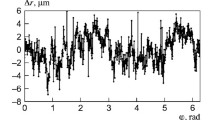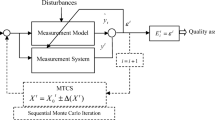Abstract
Industrial parts are routinely affected by dimensional and geometric errors originated in the course of manufacturing processes. These errors, whose pattern is typically related to a specific machining or forming process, are controlled in terms of dimensional and geometrical tolerances (such as e.g. straightness, roundness, flatness, profile) that require verification. In the last two decades, the Kriging model has been put forward for predicting errors of surfaces, whose tolerances are verified using coordinate measuring machines (CMMs), commonly used for 3D measurement on account of both accuracy and flexibility. Kriging is stochastic linear interpolation technique based on an evaluation of how the variance between responses at different points depends on the distance between the two locations. This can be expressed as a variogram which shows how the average difference between values at points changes; it is a function of the distance and of the corresponding direction of any pair of points depicting their correlation extent. The use of the variogram for identifying the correlation structure is recommended by the geostatisticians even if the stochastic process is not stationary. In this paper we resort to empirical variograms to detect possible manufacturing signatures, i.e. systematic pattern that characterises all the features manufactured with a particular production process, and systematic errors of the CMM measurement process. We simulate planar surfaces affected by different and typical manufacturing signatures and possible errors of a measurement process. The behaviour of the variogram gives evidence of spatial correlations, enlightening possible non isotropy. More specifically, we recommend the variograms in different directions of the axis because they draw attention to trend components with a specified direction.











Similar content being viewed by others
Notes
In the technical language of Metrology this means that they are geometrically described as a plane surface
References
AMSE Y14.5.1M (1994) Mathematical definition of dimensioning and tolerancing principles. The American Society of Mechanical Engineers, New York
Chilès JP, Delfiner P (2012) Geostatistics. Modeling spatial uncertainty, 2nd edn. Wiley Series in Probability and Statistics. Wiley, Hoboken. https://doi.org/10.1002/9781118136188
Cressie NAC (1988) Spatial prediction and ordinary kriging. Math Geol 20(4):405–421. https://doi.org/10.1007/BF00892986
Cressie NAC (1993) Statistics for spatial data. Wiley Series in Probability and Mathematical Statistics: Applied Probability and Statistics. Wiley, New York
Cressie NAC, Hawkins DM (1980) Robust estimation of the variogram. I. J Int Assoc Math Geol 12(2):115–125
Genton MG (1998) Highly robust variogram estimation. Math Geol 30(2):213–221. https://doi.org/10.1023/A:1021728614555
Haslett J (1997) On the sample variogram and the sample autocovariance for non-stationary time series. J R Stat Soc, Ser D Stat 46(4):475–484
ISO 25178–604:2013(E), (2013) Geometrical product specification (GPS)-surface texture: areal-nominal characteristics of non-contact (coherence scanning interferometric microscopy) instruments. Standard, International Organization for Standardization, Geneva
Journel AG, Huijbregts CJ (1978) Mining geostatistics. Academic Press, Cambridge
Krige DG (1951) A statistical approach to some basic mine valuation problems on the witwatersrand. J S Afr Inst Min Metall 52(6):119–139
Matheron G (1962) Traité de géostatistique appliquée. No. v. 1 in Mémoires du BRGM, Éditions Technip
Pedone P, Vicario G, Romano D (2009) Kriging-based sequential inspection plans for coordinate measuring machines. ASMBI 25:133–149
Pistone G, Vicario G (2016) A note on semivariogram. In: Di Battista T, Moreno E, Racugno W (eds) Topics on methodological and applied statistical inference. Springer, New York, pp 181–190
Pistone G, Vicario G (2018) How to model the covariance structure in a spatial framework: variogram or correlation function? In: Skiadas C (ed) 4th SMTDA Conference Proceedings, 1–4 June 2016. Springer, Valletta, Malta
Possolo A (2016) Spatial statistics: marks, maps, and shapes. Qual Eng 28(1):69–90
R Core Team (2014) R: a language and environment for statistical computing. R Foundation for Statistical Computing, Vienna. http://www.R-project.org/
Ribeiro P Jr, Diggle P (2001) geoR: a package for geostatistical analysis. R-NEWS 1(2):15–18. http://cran.R-project.org/doc/Rnews
Sacks J, Schiller SB, Welch WJ (1989a) Designs for computer experiments. Technometrics 31(1):41–47
Sacks J, Welch WJ, Mitchell TJ, Wynn HP (1989b) Design and analysis of computer experiments (with discussion). Stat Sci 4:409–435
Santner TJ, Williams BJ, Notz WI (2003) The design and analysis of computer experiments. Springer Series in Statistics. Springer, New York
Technical Committeee ISO/TC 213 (2013) Dimensional and geometrical product specification and verification. Bs en iso 25178-2:2102. Part 2. International Organization for Standardization, Geneva
Tobler W (1970) A computer movie simulating urban growth in the detroit region. Econ Geogr 46:234–240
Vicario G, Craparotta G, Pistone G (2016a) Meta-models in computer experiments: kriging versus artificial neural networks. Qual Reliab Eng Int 32:2055–2065
Vicario G, Giraudo MT, Calì V (2016b) Kriging modelization in predicting metal sheet elongation. Qual Reliab Eng Int. https://doi.org/10.1002/qre.2347
Yang TH, Jackman JK (2000) Form error estimation using spatial statistics. J Manuf Sci Eng 122(1):262–272
Author information
Authors and Affiliations
Corresponding author
Additional information
G. Pistone is supported by de Castro Statistics Initiative, Collegio Carlo Alberto, and GNAPA-INdAM.
Rights and permissions
About this article
Cite this article
Vicario, G., Pistone, G. Simulated variogram-based error inspection of manufactured parts. Stat Papers 59, 1411–1423 (2018). https://doi.org/10.1007/s00362-018-1030-0
Received:
Revised:
Published:
Issue Date:
DOI: https://doi.org/10.1007/s00362-018-1030-0




